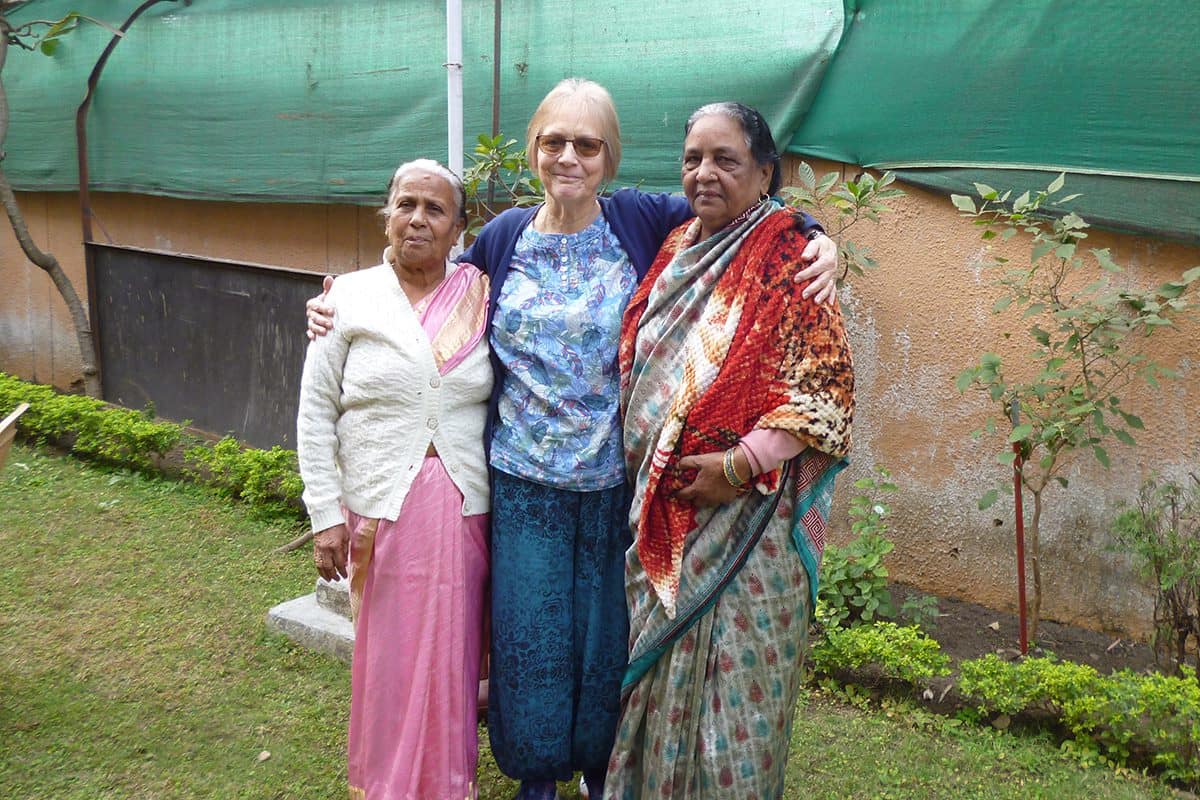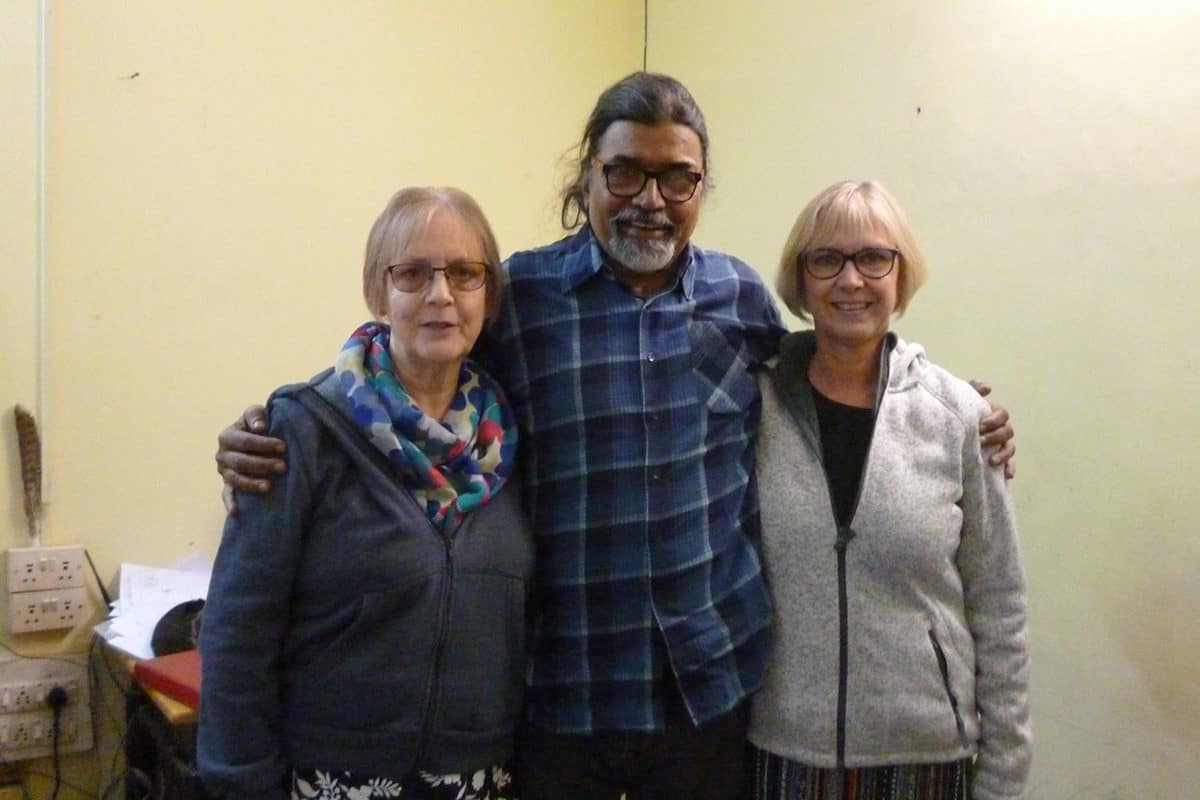Today we are pleased to share a story from one of our longest standing supporters and contributors, Fiona Case, about her visit to Bhopal and the Sambhavna and Chingari clinics last year. In addition to running regular fundraisers for the charity, along with her husband Michael, Fiona is also our coordinator for the litter picking team at the Glastonbury festival each year, raising thousands of pounds for the charity annually. We would like to take this opportunity to thank her for her incredible hard work and support these past years, as well as for sharing this story with all of us. We are delighted that she was able to visit Bhopal and meet the survivors for herself. Below is her account of the trip in her own words.
Fiona’s Story
In March, the Women’s Institute invited me to give a talk about my trip to Bhopal, India, but sadly Covid-19 and lockdown meant it had to be abandoned. I’m hoping it might happen in 2021 when I can show pictures but, in the meantime, here is a brief summary of my talk.
I have been a supporter of the Bhopal Medical Appeal charity ever since it started 26 years ago, and have held numerous fundraising events since then with the magnificent help of family and friends. Together with Glastonbury Festival’s support, we have managed to raise £142,000!
I had never been to Bhopal for financial reasons as well as ethical – if I’d had the money wouldn’t it be better to give it to the charity? However, on my big birthday last year, my husband persuaded family and friends to donate to a fund to allow me to visit. It was the most amazing gift and I’m so very grateful to everyone who supported me. My sister, Jan, not wanting me to travel alone, could afford to join me and we set off at the end of December last year.
Arriving in Delhi on Sunday 30th December after 30 hours of exhausting travel, with fog delays and 2½ hours queuing for immigration, we reached our hotel, fell across the bar and ordered large G&T’s! After 4 hours sleep we returned to the airport for our flight to Bhopal. Fog had again delayed the flight so without time to settle into our next hotel, we jumped into a taxi and sped off to meet Tabish (BMA Communications Officer) at the Chingari Rehabilitation Centre. The BMA also funds this clinic, which was opened in 2006 to give therapies and education to children of survivors.
Chingari was set up by two brave women, Rasheeda Bee and Champadevi Shukla, survivors of the disaster who, despite their poor health ran a campaign seeking justice for the women and children of Bhopal. They won an award for their work and, using the £70,000 prize money, started the Rehabilitation Centre. Chingari means ‘spark’, as in a fire, and the Centre is certainly an amazing place. It’s housed on the ground floor of a derelict government building and is cramped and tatty, but is joyful and full of colour. Approximately 120 children are treated each day, in two sessions, and they get a hot meal too. Tabish showed us round the rooms for speech and auditory therapy, the sensory stimuli room and the physios. We saw children with twisted limbs being patiently worked on to straighten them. The kids also receive an education, and the walls are covered with their drawings.

Next day was New Year’s Eve and in the afternoon we were invited to a party at Chingari. It was so emotional. The kids were dressed in their best, brightest clothes and the excitement and noise was sky-high. Being treated like VIP’s was very humbling. Our lives are so privileged, but these poor people welcomed us, coming up to meet us and shake our hands. There were sack races then dancing performances by the children and the staff sang a song. It was a long afternoon but absolutely awe-inspiring.
Before the party Tabish had taken us to the Sambhavna Clinic where we met Sathyu Sarangi, the Managing Trustee. As an engineer, he came to Bhopal the day after the disaster to try and help and he’s never left! He is the founder of the Sambhavna Trust which runs the clinic and is a passionate, intelligent man. He showed us round the buildings and the garden where the herbs are grown for the ayurvedic medicines. We saw two ladies making pills by grinding herbs with a large pestle & mortar, looked in the laboratories for treatment research and saw outreach researchers who are studying health impacts. The clinic treats up to 200 people a day, each getting seven minutes with a doctor. There are 37,000 registered patients, two thirds gas-related and one third waterborne related. Disorders include scarred lungs, diabetes, cardio-vascular disease, cancers and gynaecological problems. Miscarriages and still births are over 50% higher than normal.

The clinic is less than half a mile from the factory site, in the centre of the gas-affected area of Bhopal where most sufferers live. With help from the staff at Chingari, official permission was granted for us to visit the site. Driving along the flyover, we saw the shanty homes right next to the fence and the ponds where Union Carbide dumped the toxic waste water. Neither the ponds nor the factory site have been cleaned up so toxins continue to leach into underground water. People still live and children play beside the ponds. The results of this neglect as well as the genetic damage done to parents can be seen in the children with twisted limbs, autism, Downs Syndrome and other neurological disorders. Thus, as the older generation of direct sufferers die, they are being replaced by a new, indirectly affected generation of sufferers. And the contaminated water is spreading to more districts.
The factory site is like a ghost town inside parkland with eerie, empty office buildings and laboratories. The tank which released gas on ‘that night’ is still there, rusting away, and pesticide pellets lie strewn on the ground. There is no sign outside to say what’s hidden inside this huge walled area, right in the heart of Bhopal. The only memorial for the victims is a Mother & Child statue outside the gate. My sister commented later ‘it was surreal’.
Next was a visit to the Remember Bhopal Museum, run by volunteers to show the true story of Bhopal in words, photos and some artefacts of those who died, including a baby’s matinee jacket. Heart-wrenching.
The BMA’s aim is principally to help the disaster sufferers but they also open their skills to others around the world suffering from chemical disasters, and has won awards for their pioneering work. Bhopal survivors are among the world’s poorest people, living in overcrowded conditions with no access to clean running water. Their health is already severely weakened making them highly vulnerable to infections – then along came Covid-19. Sambhavna and Chingari have set up a ‘community shield’, handing out leaflets and training volunteers to help identify, isolate, and treat Covid sufferers. Hand-washing stations have been set up, food and medicines are being delivered. Although gas survivors formed only a third of Bhopal’s population in 1984, they now make-up nearly three quarters of its Covid-19 deaths. To live 36 years of pain and suffering and then end with Covid seems to be the final injustice, but one lesson I have learned from Bhopal is that hope, kindness and generosity are more important than anything else in the world.
Jan and I made the most of sightseeing in Bhopal and made brief visits to other cities. As she said, ‘it was not a holiday, it was an experience’!’ So, my sincere thanks again to everyone who has supported the people of Bhopal over the years, and who gave me the glorious opportunity of seeing the results myself.
Fiona Case


